Guide for Businesses and Suppliers

We’ve covered the basics of days payable outstanding before, but today we are going to examine the idea more closely as it applies to collection and accounts receivable. How does DPO affect your business’ accounts receivable as a service provider or supplier? How does it help with ensuring that debts are paid in a timely manner? Let’s take a look.
Brief Review of Days Payable Outstanding
A quick refresher on DPO: this is the activity ratio measuring the average amount of time it takes a business to pay a bill on short term credit. The lower the DPO number, the faster a business pays what it owes. It also allows creditors to determine the normal repayment terms that a business receives from its suppliers. Companies with a higher DPO usually have better repayment terms from their suppliers, so their credit is considered good among the vendors they do business with on a regular basis. Low DPO numbers mean that a company must pay its invoices more quickly, meaning that they have tighter restrictions on their repayment terms. So, high DPO reflects well on a business’ reputation; low DPO is considered a deterioration or lower standing with creditors.
Managing DPO as a Business
For owners, it is essential to maintaining a good reputation with your suppliers to manage your DPO appropriately. Paying on time fastidiously all the time means that your business has less cash on hand on a regular basis, making your monthly balance sheet look cash poor regarding financial liquidity. This is especially true if your customers do not pay your business for its products and services on time, or if they pay outside the payment terms laid out by your vendors. Your business ends up fronting a lot of the cost of doing business until your customer pays you.
What’s the solution to this dilemma? Incentivize your customers to pay for the goods and services you supply on time or close to the payment terms of your suppliers. Offer discounts or periodic bonuses for early payment or timely payment to be able to pay your suppliers within a reasonable amount of time.
The trick to this is managing your repayment terms with your creditors and customers, so your DPO ratio stays higher instead of lower. You need to maintain a high cash flow in order to keep your business healthy, but at the same time, you have to pay your bills with your creditors to maintain your credit. DPO often becomes a series of brinksmanship maneuvers where each side is trying to keep their cash flow high by collecting payments on time without reducing their DPO. The time to establish this balance is during supplier contract negotiation so that terms are clearly understood, and you can hopefully strike a deal that allows you to maintain a higher cash on hand and a longer DPO. Now that we have a better understanding of a business’ motivation and reasoning behind maintaining a high DPO, let’s examine how suppliers have to treat these businesses when dealing with short term credit for their accounts receivable.
DPO for Suppliers and Accounts Receivable
As a supplier, you provide the raw and production grade materials to manufacturers in exchange for the promise of payment. Your cash has already been spent to acquire those materials and provide them to the manufacturer. Your cash flow is dependent upon your buyers paying their invoices for supplies. In order to make sure that your accounts are paid up, and money is on hand, you have to ensure that you collect on those invoices regularly. One way to make sure you get paid is to offer discounts and bonuses for timely payment, just like most manufacturers do for customers and resellers. The key difference as a supplier is that you want your buyers to know they can maintain a high DPO and keep their cash on hand, but at the same time, you have to keep your cash flow moving as well.
During supply contract negotiation, you will need to keep in mind that buyers are looking to keep their DPO higher and more cash on hand. Finding a compromise between your needs and their needs is how business gets done. Before doing business with a new client, see if you can find their average DPO from past financial statements and public financial records. While these numbers are not always accurate, they do indicate enough to get a rough estimate of a company’s DPO numbers. You can also check around with other suppliers to find out how long it takes them on average to pay their invoices. These are sound practices to ensure that every supply contract is equitable for both parties.
Overall, understanding DPO and its impact on both businesses and creditors are essential to maintaining solid accounts receivable practices. Make sure that you are accounting for DPO when negotiating repayment terms with an eye towards maintaining your cash flow.

